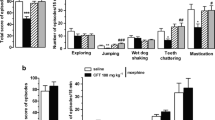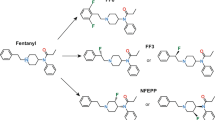Summary
The effects of opioids on the permeability of the blood-brain barrier (BBB) were examined in mice with sodium fluorescein as an indicator of the permeability. The brain was perfused with saline 30 min after injection of sodium fluorescein (40 mg/kg, i. v.) and examined by fluorometry. Morphine hydrochloride (0.3–10 mg/kg, s. c.) markedly increased the brain level of sodium fluorescein dose-dependently without influencing the plasma level, when administered 20 min before sodium fluorescein injection. Intracerebroventricularly (i. c. v.) injected morphine hydrochloride (0.5 and 1.0 Erg) increased the brain sodium fluorescein level. Buprenorphine (0.1 and 0.5 mg/kg, s. c.) was also effective. However, pentazocine, ethylketazocine, U-50488H and SKF-10047 had no significant influence. The i.c.v. administration of [D-Ala2, McPhe4, Gly(ol)5]enkephalin (0.1 μg) and [D-Ala2, D-Leu5]enkephalin (0.5 μg) but not of [D-Thr2, Leu5]enkephalin-Thr increased the brain level of sodium fluorescein significantly. A small dose of naloxone (i. p.) significantly inhibited the effects of morphine, buprenorphine, [D-Ala2, McPhe4, Gly(ol)5]enkephalin and [D-Ala3, D-Leu5]enkephalin. ICI-174864 co-administered i. c. v. with [D-Ala2, D-Leu5]enkephalin was ineffective in antagonizing the effect of the latter. These findings suggest that the stimulation of µ opioid receptors results in an increase in BBB permeability to sodium fluorescein.
Similar content being viewed by others
References
Brase DA, Iwamoto ET, Loh HH, Way EL (1976) Reinitiation of sensitivity to naloxone by a single narcotic injection in postaddicted mice. J Pharmacol Exp Ther 197:317–325
Corbett AD, Gillan MGC, Kosterlitz HW, McKnight AT, Paterson SJ, Robson LE (1984) Selectivities of opioid peptide analogues as agonists and antagonists at the δ-receptor. Br J Pharmacol 83:271–279
Cotton R, Giles MG, Miller L, Shaw SJ, Timms D (984) ICI 174864: A highly selective antagonist for the opioid δ-receptor. Eur J Pharmacol 97:331–332
Domer FR, Boertje SB, Bing EG, Reddix I (1983) Histamine- and acetylcholine-induced changes in the permeability of the blood-brain of normotensive and spontaneously hypertensive rats. Neuropharmacology 22:615–619
Domino EF (1979) Opiate interaction with cholinergic neurons. Adv Biochem Psychopharmacol 20:339–355
Duckles SP (1981) Evidence for a functional cholinergic innervation of cerebral arteries. J Pharmacol Exp Ther 217:544–548
Fukui K, Shiomi H, Takagi H (1972) Effect of morphine on tyrosine hydroxylase activity in mouse brain. Eur J Pharmacol 19:123–125
Goldstein AJames IF (1984) Multiple opioid receptors: Criteria for identification and classification. Trends Pharmacol Sci 5:503–505
Gulati A, Nath C, Shanker K, Dhawan KN, Bhargava KP (1982) Fluorescein spectrophotofluorometry: A sensitive quantitative method for evaluating the blood brain barrier. Pharmacol Res Commun 14:649–661
Haley TJ, McCormick WG (1957) Pharmacological effects produced by intracerebral injection of drugs in the conscious mouse. Br J Pharmacol 12:12–15
Handa BK, Lane AC, Lord JAH, Morgan BA, Rance MJ, Smith CFC (1981) Analogues of β-LPH 61–64 possessing selective agonist activity at µ-opiate receptors. Eur J Pharmacol 70:531–540
Heyman JS, Mulvaney SA, Mosberg HI, Porreca F (1987) Opioid αreceptor involvement in supraspinal and spinal antinociception in mice. Brain Res 420:100–108
Hoffman HJ, Olszewski J (1961) Spread of sodium fluorescein in normal brain tissue. Neurology 11:1081–1085
Jaffe JH, Martin WR (1985) Opioid analgesics and antagonists. In: Gilman AG, Goodman LS, Rall TW, Murad F (eds) The pharmacological basis of therapeutics. MacMillan, New York, pp 491- 531
Kobayashi H, Magnoni MS, Govoni S, Izumi F, Wada A, Trabucchi M (1985) Neural control of brain microvessel function. Experimentia 41:427–434
Lahti RA, Von Voightlander, Barsuhn C (1982) Properties of a selective kappa agonist. U-50,488H. Life Sci 31:2257–2260
Lange DC, Fujimoto JM, Roerig S, Wang RIH (1977) Enhanced naloxone distribution to the brain by morphine pretreatment in mice. Drug Metab Disp 5:167–173
Magnan J, Paterson SJ, Tavani A, Kosterlitz HW (1982) The binding spectrum of narcotic analgesic drugs with different agonist and antagonist properties. Naunyn-Schmiedeberg's Arch Pharmacol 319:197–205
McGilliard KL, Takemori AE (1978) Alterations in the antagonism by naloxone of morphine-induced respiratory depression and analgesia after morphine pretreatment. J Pharmacol Exp Ther 207:884–991
Nishibori M, Oishi R, Itoh Y, Saeki K (1985) Morphine-induced changes in histamine dynamics in mouse brain. J Neurochem 45:719–724
Oishi R, Ozaki M, Takemori A (1983) In vivo binding of naloxone to opioid receptors in morphine-dependent mice. Neuropharmacology 22:1015–1019
Paterson SJ, Magnan J, Tavani A, Kosterlitz HW (1981) In: Takagi H, Simon EJ (eds) Advances in endogenous and exogenous opioids. Kodansha, Tokyo, pp 2–4
Patrick GA, Dewey WL, Spaulding TC, Harris LS (1975) Relationship of brain morphine levels to analgesic activity in acutely treated mice and rats and in pellet-implanted mice. J Pharmacol Exp Ther 193:876–883
Pert CB, Snyder SH (1975) Identification of opiate receptor binding in intact animals. Life Sci 16:1623–1634
Preskorn SH, Hartman BK, Raichle ME, Clark HB (1980) The effect of dibenzazepines (tricyclic antidepressants) on cerebral capillary permeability in the rat in vitro. J Pharmacol Exp Ther 213:313–320
Raichle ME, Hartman BK, Eichling JO, Sharpe LG (1975) Central noradrenergic regulation of cerebral blood flow and vascular permeability. Proc Natl Acad Sci USA 72:3726–3730
Reinhard JF, Liebman JE, Schlosberg AJ, Moskowitz MA (1979) Serotonin neurons project to small blood vessels in the brain. Science (Wash) 206:85–87
Smith CB, Sheldon MI, Bednarczyk JH, Villarreal JE (1972) Morphine-induced increase in the incorporation of 14-C-tyrosine into 14-C-dopamine and 14-C-norepinephrine in the mouse brain, antagonism by naloxone and tolerance. J Pharmacol Exp Ther 180:547–557
Takemori AE, Ikeda M, Portoghese PS (1986) The µ, κ and δ properties of various opioid agonists. Eur J Pharmacol 123:357–361
Tervo T, Joo F, Palkama A, Salminen L (1979) Penetration barrier to sodium fluorescein and fluorescein-labelled dextrans of various molecular sizes in brain capillaries. Experimentia 35:252–254
Wolman M, Klatzo I, Chui E, Wilmes F, Nishimoto K, Fujiwara K, Spatz M (1981) Evaluation of the dye-protein tracers in pathophysiology of the blood-brain barrier. Acta Neuropathol 54:55–61
Yarbrough GG, Buxbaum DM, Sanders-Busch E (1972) Increased serotonin turnover in acutely morphine-treated mice. Biochem Pharmacol 21:2667–2669
Zajac JM, Gacel G, Petit F, Dodey P, Rossignol P, Rogues BP (1983) Deltakephalin, Tyr-DThr-Gly-Phe-Leu-Thr: A new highly potent and fully specific agonist for 6-receptors. Biochem Biophys Res Commun 111:390–397
Author information
Authors and Affiliations
Additional information
Send offprint requests to K. Saeki
Rights and permissions
About this article
Cite this article
Baba, M., Oishi, R. & Saeki, K. Enhancement of blood-brain barrier permeability to sodium fluorescein by stimulation of µ opioid receptors in mice. Naunyn-Schmiedeberg's Arch Pharmacol 337, 423–428 (1988). https://doi.org/10.1007/BF00169534
Received:
Accepted:
Issue Date:
DOI: https://doi.org/10.1007/BF00169534




